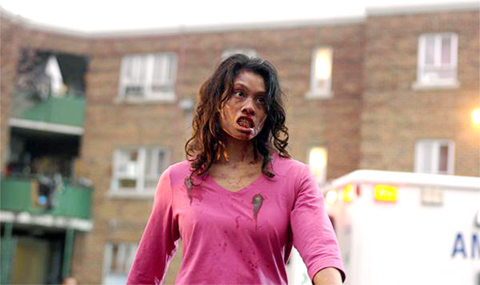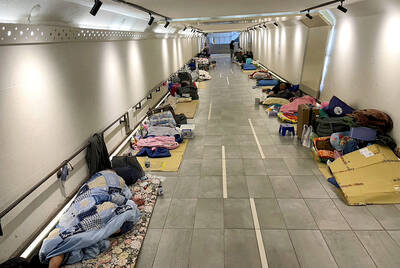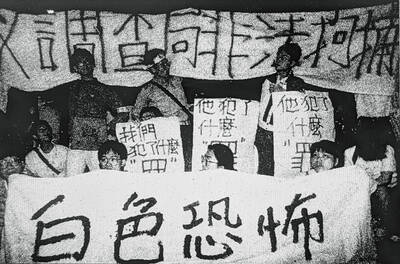When young filmmakers gather to shoot cinema verite video documentaries, watch out: Something really bad is going to happen. In The Blair Witch Project, it was ... well, we don’t really know what it was, but it sure freaked out Heather. In Cloverfield, it was something large with an antipathy toward Manhattan landmarks. And in George A. Romero’s Diary of the Dead, as you have probably gathered by now, it is the meat-eating undead. These movies give the shaky-cam a reason to get shaky — but the kids try not to miss a shot.
Diary is ostensibly edited by Debra (Michelle Morgan) from handheld footage shot on the run by her film-student boyfriend, Jason (Josh Close), and some of their friends. They’ve been collaborating on Jason’s horror-movie student project, overseen by their alcoholic film professor, Maxwell (Scott Wentworth), who’s just about the only person over 30 in the entire film, except for an old Amish guy who swings a mean scythe. The writer-director may be 68, but Diary is targeted at the Young of Intestines, a generation for whom zombie movies and Web video are facts of everyday life, as natural as eating flesh.
This is the fifth of Romero’s Living Dead series, which started 40 years ago.

PHOTO: COURTESY OF GROUP POWER
In Night of the Living Dead Romero used radio and television news broadcasts to envelop an isolated Pennsylvania farmhouse in an atmosphere of invisible but impending menace, the unseen specter of a larger world gone undead. Now those technologies have been all but supplanted by videocams, security surveillance monitors and laptops with broadband Web connections. Nobody believes the government spin spread by conventional mass media anymore. Bloodthirsty corpses have run amok in the streets, and the Homeland Security Alert has been temporarily raised to orange. It’s up to citizen-journalist bloggers and amateur videographers to capture and disseminate the raw, unfiltered story of what’s really going on, to show you the horrific truth they won’t put on TV.
Does this scenario remind you of anything? Diary presents a world of post-Sept. 11, post-Iraq-invasion paranoia and distrust of the “official story.” (We used to call this “post-Watergate” skepticism, but we’re post-that now.) The zombies you can see. You can run them over in your Winnebago or take them down with a shot to the head. But the larger monster is uncertainty: What is happening? Why? And where will it strike next?
“I think that’s what started the panic — not knowing the truth,” one character says. This is what really puts the “terror” in “terrorism,” not the flesh-ripping shenanigans of the suicide-zombies right there in front of you — although they do tend to surprise you by lunging from just beyond the edge of the frame. When Debra takes a moment to reflect on a future of endless war, in which every person who is killed returns from the dead to kill someone else, she’s talking about the cycles of vengeance and violence in places like Iraq and Afghanistan — blowback, not just biteback.
At the beginning of the picture, Debra tells us that she’s assembled the feature we’re about to see — The Death of Death, a doc in the vein of Internet Sept. 11 conspiracy exposes like Loose Change — and has added music in some scenes because she wants to scare us into waking up to the truth: “I am trying to scare you.”
Well, with just two videocams and a dwindling number of operators, they never quite get the truth, just some juicy fragments here and there. And Diary of the Dead isn’t really all that scary. Even a mansion swarming with the undead is no match for the theatrical competition of, say, Daniel Plainview or Anton Chigurh. But while horror provides the marketing hook, Romero’s movies are even more entertaining for their zesty socio-political satire, and like its ancestors, Diary explodes like an undead noggin with that stuff. A favorite touch: Someone on a talk radio show is overheard remarking that the real “immigration problem” is now about people crossing the border between life and death.
“There’s always a market for horror — believable horror,” director Jason expounds during a nighttime location shoot for his mummy movie. You may not believe in zombies, but the unnamed dread in the air of Diary of the Dead is recognizably believable because we live with it now.

From the last quarter of 2001, research shows that real housing prices nearly tripled (before a 2012 law to enforce housing price registration, researchers tracked a few large real estate firms to estimate housing price behavior). Incomes have not kept pace, though this has not yet led to defaults. Instead, an increasing chunk of household income goes to mortgage payments. This suggests that even if incomes grow, the mortgage squeeze will still make voters feel like their paychecks won’t stretch to cover expenses. The housing price rises in the last two decades are now driving higher rents. The rental market

July 21 to July 27 If the “Taiwan Independence Association” (TIA) incident had happened four years earlier, it probably wouldn’t have caused much of an uproar. But the arrest of four young suspected independence activists in the early hours of May 9, 1991, sparked outrage, with many denouncing it as a return to the White Terror — a time when anyone could be detained for suspected seditious activity. Not only had martial law been lifted in 1987, just days earlier on May 1, the government had abolished the Temporary Provisions Effective During the Period of National Mobilization for Suppression of the Communist

Hualien lawmaker Fu Kun-chi (傅?萁) is the prime target of the recall campaigns. They want to bring him and everything he represents crashing down. This is an existential test for Fu and a critical symbolic test for the campaigners. It is also a crucial test for both the Chinese Nationalist Party (KMT) and a personal one for party Chairman Eric Chu (朱立倫). Why is Fu such a lightning rod? LOCAL LORD At the dawn of the 2020s, Fu, running as an independent candidate, beat incumbent Democratic Progressive Party (DPP) lawmaker Hsiao Bi-khim (蕭美琴) and a KMT candidate to return to the legislature representing

Fifty-five years ago, a .25-caliber Beretta fired in the revolving door of New York’s Plaza Hotel set Taiwan on an unexpected path to democracy. As Chinese military incursions intensify today, a new documentary, When the Spring Rain Falls (春雨424), revisits that 1970 assassination attempt on then-vice premier Chiang Ching-kuo (蔣經國). Director Sylvia Feng (馮賢賢) raises the question Taiwan faces under existential threat: “How do we safeguard our fragile democracy and precious freedom?” ASSASSINATION After its retreat to Taiwan in 1949, the Chinese Nationalist Party (KMT) regime under Chiang Kai-shek (蔣介石) imposed a ruthless military rule, crushing democratic aspirations and kidnapping dissidents from